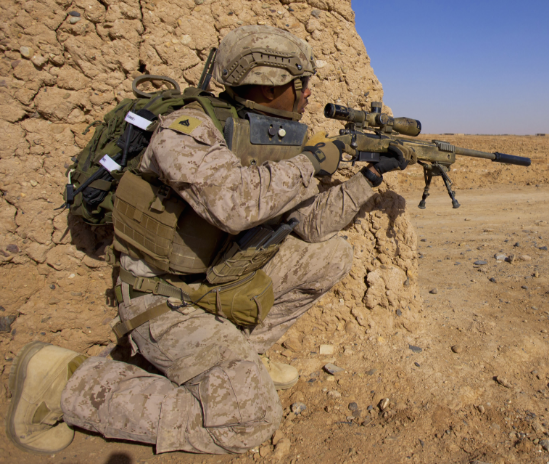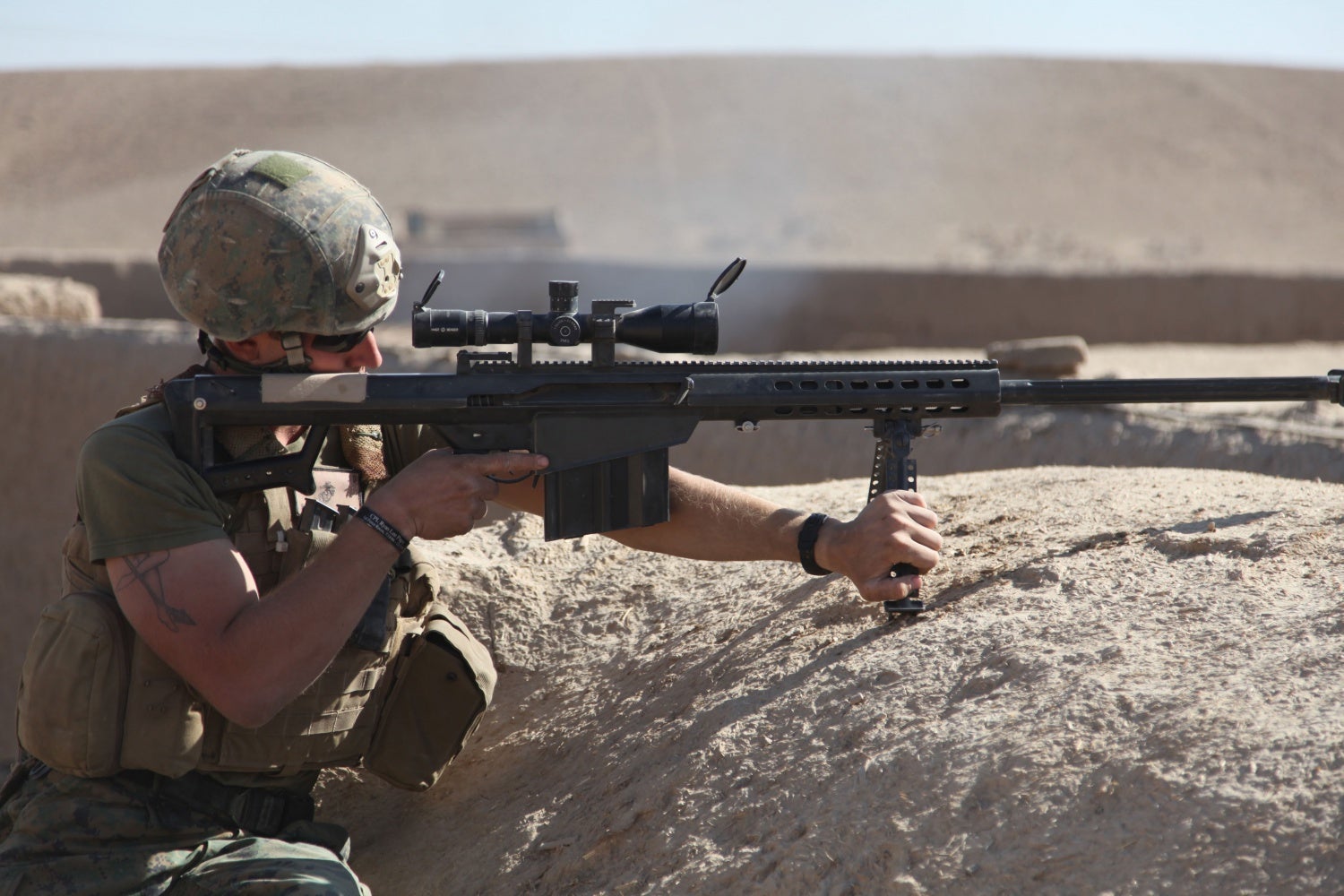The Marine Corps Times (not associated with the Marines) has highlighted an issue that hasn’t entered the public domain in firearms news as of yet, but has really been smoldering at the surface for many years now. The basic premise of the issue is this: The operational active-duty infantry battalions in the Fleet Marine Force aren’t getting enough school trained Scout Snipers and it is hurting their ability to maintain peak effectiveness within the FMFScout Sniper platoons. Reasoning behind this? Not enough Marines are passing Sniper School while there are plenty of Marines that enter it. The problem? The majority of candidates in the school are failing the Scout Sniper Basic Courses taught at Camp Geiger, NC, Camp Pendleton, CA, and Quantico in northern Virginia. Currently, the rate at which classes are passing is 44 percent, which means essentially half of each Basic Course class is dismissed before going on to the advanced stages.
Unlike most articles, even about the Marine Corps from the Marine Corps Times, this one is relatively spot on. I’d like to point out that this is the same publication that made front page headlines out of a single forum post in 2010 about whether non-Infantry MOS’ deserved to wear crossed rifles on their insignia. Essentially blowing some non-issue scuttle-butt into epic proportions it should have never gotten to, to begin with.
As reported by the Times, the Ground Combat Element deputy infantry advocate of the Plans, Policies, and Operations command has announced the following solution to get the same quality of scout sniper while increasing the graduation rate of the 79 day Basic Course-
Starting this spring the Corps will experiment with breaking up the training into two parts. Between the two parts, those Marines would be assigned to an operational unit, a Marine Corps official said.“Traditionally, there’re two areas that challenge our students: one is stalking and the other is marksmanship skills,” the Marine Corps official said.
“The intent is to give a sniper student the basic skills they need to join their unit under seasoned scout snipers,” the official said. “Then they will be doing on-the-job-training in operational environments and performing certain skills, holding certain billets at a lower level in their teams to gain experience and be mentored and coached under the senior scout snipers prior to going to the advanced course and hopefully having a greater chance of success.
So essentially the Marine Corps is looking to accomplish what the Platoon Leaders Course does, in that it splits the same training regime over two different time periods in order to accomplish larger time schedules and operational goals. Thus, a candidate from a Sniper platoon will attend half of the Basic Course, provided he passes, goes back to his Fleet platoon, gets more experience, then returns to hopefully complete the other half of the same course.
Although this might sound like a solution, in theory, I don’t believe this is going to be an actual workable solution for a number of different reasons that I’ll go into in depth.
The Real Problem
The Marine Corps Scout Sniper Schools are the best combined precision marksmanship and observation packages in the United States Military, Period. I don’t say this because I’m a former Marine Infantryman, or because I myself was in a Sniper platoon, or even because I attended the Basic Course (and subsequently washed out). I say this because what the Marine Corps offers as a Scout Sniper puts anything any of the other services have to dust. The biggest reason is that the capabilities that we offer aren’t offered in the same package elsewhere. The Army, the SEAL teams, even MARSOC each have their own sniper schools, but none of them offer the scouting package that the Marine Corps offers. They offer an excellent shooting package, but not to the extent that the Marine Corps goes in teaching snipers how to act as FOs for artillery/CAS, stalking, patrolling, and observation, they don’t come close. As an example, the class that I was a part of had several MARSOC guys, and the class before me had three SEALs, two of which failed our Basic Course. Much of the education that the Marine Corps offers is a direct result of bloody lessons learned in the jungles of South Vietnam.
The problem however, is that the reputation of the 0317 community hasn’t changed with the times. As an example, stalking is still being taught to this very day, and is one of the hardest and most failed portions of the school. Many question the validity of stalking, possibly being more useful in Vietnam than in the cities of Iraq, and the mountain valleys of Afghanistan. However, what few realize is that the patience and perseverance, in addition to the utility of camouflage that allows a student to successfully pass a stalk lane against a watching instructor, are the same skill sets that are drastically important on today’s battlefield. Our Scout Snipers practice a sort of art form that doesn’t really exist anymore in the conventional forces of today.
The rigid standards that exist at the schools today have been in place since the 1970s and 80s, essentially closely guarded by generations of Scout Sniper Instructors. However, the operational requirements of today, are not the same as they were in the 1970s, 80s, and 90s. They are much higher with the deployments on MEUs, Black Sea Rotations, and dreaded Okinawa. During OIF and OEF there was a massive surge of enlistments. So although there were more Marines the force-wide overall, more students at the Basic Course, the standards were able to stay the same. Also bear in mind that the school houses have gone through numerous changes over the past decade to accommodate this need for more graduates, but none so drastic that the graduation rate is essentially being cut in half.
During OIF and OEF there was a massive surge of enlistment and re-enlistment throughout the years units were deploying overseas. So although there were more Marines force-wide overall, thus more students at the Basic Course, the standards were able to stay the same. Also bear in mind that the school houses have gone through numerous changes over the past decade to accommodate this need for more graduates, but none so drastic that the completion rate is essentially being cut in half.
From the Marine Corps logistic point of view, there needs to be more Scout Snipers. From a budget point of view, it’s impossible to increase this number without adding more schools or more preparatory training which both cost money. But most importantly from the Scout Sniper Instructors, they won’t decrease their standards to produce a sub-standard Scout Sniper. Unless of course that is what the Marine Corps wants overall, but I gravely doubt this.
Thus, from the viewpoint of an admin officer, apparently splitting the course in two sounds like a surefire way to maintain the same quality of Scout Sniper while generating more 0317s.
The Time
From a simple time line perspective, it is very hard for me to see this working out. Let’s do some simple math here, so bear with me. So the majority of Infantry Marines have a four year contract, let’s break that into months, which is 48 months. Minus 5 months for Boot Camp/School of Infantry is 43. Now the average Infantryman these days usually sees two deployments per term of enlistment. Each deployment is 7 months, plus about a month of combined leave, that makes 16 months total of either being deployed overseas or on leave. Now we are at 27 months in the Fleet, doing good so far. However, each unit will conduct a work up for that deployment that is usually 5-6 months long prior to deploying. During this period, units have to stay together to build up that inherent teamwork. So we’ll subtract 10 months from that 27, leaving us at 17. Now, Seps/Taps is the Marine Corps’ outbound separation program, which usually requires 3 months (90 days) of a Marine’s time prior to his EAS date, dedicated for him to be checking out of his unit, turning in gear, etc… So now we are at 15 months of training time. It looks like we have a lot to work with here, 15 months in the Fleet to go to Sniper School, what’s the issue?
The issue is that no Sniper Platoon is going to send a Boot to school (PC word=New Join). It does happen, but rarely and almost never works. A spot in the Basic Course is highly coveted in Scout Sniper platoons. Think of it like this: Each school serves an entire coast, with Quantico taking up the slack from both coasts when spots aren’t available at the Gieger or Pendleton schools. So if we take Geiger where I failed out of, essentially we have one school house, that can only take around 30-40 candidates per class, serving three Infantry regiments. Broken down, 3 regiments have 3 battalions, each have their own Scout Sniper Platoon. The math equates to around a combined total of 200 Marines in these platoons (roughly 20-25 eligible Marines in each platoon). We’re going to double this number for one year to 400. This is accounting for guys leaving the platoon, incoming Boots, casualties, etc…
So, a Basic Course is roughly 3 months long, including the several weeks delay between each course, so that makes for Basic Courses that a school can support a year, sometimes three. If you do the math, for every spot available in those 3-4 Basic Course classes, you literally have anywhere from 10-16 Marines vying to get into one spot. Of course, these numbers are somewhat smaller at the platoon level, but the facts remain that there is a very high demand and very little supply of available class slots. In addition, there are only 3-4 Basic Courses per year on whichever coast you pick. Of course, if you’re the Chief Scout of a platoon you could try to send a guy across the country to Pendleton when at Lejeune, or vice versa. But is your battalion really going to fund that when it could send an NCO off to become JTAC qualified for a cheaper price on base, and a higher graduation rate? Probably not.
 Your Privacy Choices
Your Privacy Choices



